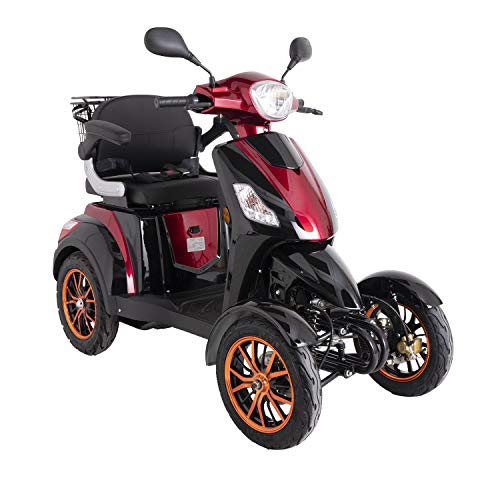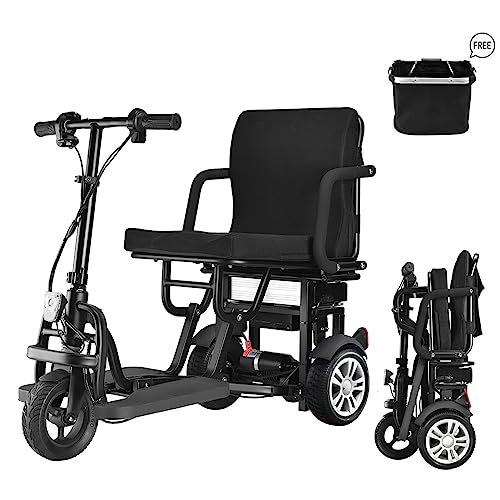10 Meetups On Mobility Devices You Should Attend
페이지 정보
작성자 Ira 작성일24-12-24 22:46 조회7회 댓글0건관련링크
본문
 Fleet Management and Smart Mobility
Fleet Management and Smart Mobility Smart mobility provides alternative transportation alternatives to private cars, encouraging public transit and carpooling. It also contributes to sustainability by cutting down on pollution and traffic congestion.
Smart mobility provides alternative transportation alternatives to private cars, encouraging public transit and carpooling. It also contributes to sustainability by cutting down on pollution and traffic congestion.These systems require high-speed connectivity between devices and road infrastructure, as well as centralized systems. They also require advanced algorithms and software to process the data that sensors collect and other devices.
Safety
Smart 4 wheel drive electric mobility scooter solutions are readily available to address different challenges in urban areas, including sustainability, air quality, and road safety. These solutions can decrease pollution and traffic congestion and make it easier for people to use transportation options. They can also help improve the management of fleets and provide passengers with more options for transportation.
As the smart mobility concept is still relatively new, there remain some hurdles to overcome before these technologies can be fully rolled out. This involves securing smart infrastructures and devices, establishing user-friendly interfaces and solid measures to protect data. It is also crucial to know the preferences and needs of different users to ensure that they are able to adopt.
Smart mobility's ability of integrating into existing infrastructure and systems is an important characteristic. Sensors can provide real-time information and enhance the performance of systems by integrating them into vehicles roads, transport components. They can track weather conditions, traffic, and vehicle health. They can also spot road infrastructure issues, such as bridges and potholes, and report them. This information can be used to improve routes, avoid delays, and minimise the impact on travelers.
A better safety record for fleets is a further benefit of smart mobility. Through advanced driver alerts and collision avoidance systems, these technologies can help to reduce accidents caused by human errors. This is especially important for business owners whose fleets are used to transport products and services.
Smart mobility solutions reduce fuel consumption and CO2 emission by facilitating a more efficient utilization of vehicles and transport infrastructure. They can also promote the use 4 wheeled electric Mobility scooter 1000W veleco faster vehicles, which can result in a decrease in pollution and cleaner air. Smart mobility can also offer alternatives to private car ownership and encourage public transportation.
As the number of smart devices is continuing to increase, there is a need for a comprehensive data protection framework that can guarantee the privacy and security of the data they gather. This includes establishing specific guidelines for what information is collected and how it's shared. Additionally, it involves implementing robust security measures, regularly re-updating systems to protect against new threats, and ensuring transparency regarding practices for handling data.
Efficiency
There's no doubt that the urban mobility system is in need of an urgent upgrade. Congestion, pollution and wasted time are all factors that can adversely affect business and the quality of life.
Companies that provide solutions to the current logistical and transportation issues will be able to profit of a growing market. However the solutions must incorporate technological innovation that will help solve key challenges like traffic management, energy efficiency, and sustainability.
The concept behind smart mobility solutions is to use various technologies in vehicles and infrastructure that will improve the efficiency of transportation, and also reduce the number of accidents, emissions and costs of ownership. These technologies generate a massive amount of information, so they need to be linked to each other and analyzed in real-time.
Luckily, a lot of technologies used in transportation include connectivity features built-in. Ride-share scooters that are unlocked and purchased using QR codes or apps autonomous vehicles, smart traffic lights are examples of such technology. These devices can also be linked to one another and centralized systems by the use of sensors and low-power wireless networks (LPWAN) and eSIM cards.
Information can be shared in real-time and actions can be swiftly taken to minimize issues like traffic jams or accidents. This is made possible by advanced machine learning algorithms and sensors data that analyzes data in order to identify patterns. These systems can also forecast future trouble spots and provide direction for drivers on how to avoid them.
Many cities have already implemented smart solutions to mobility to ease congestion. Copenhagen, for example, uses intelligent traffic signals that prioritize cyclists during rush hour to reduce commute times and encourage biking. Singapore has also introduced automated buses that follow designated routes by using a combination of sensors and cameras to improve public transportation services.
The next phase of smart mobility will be based on advanced technology, including artificial intelligence and big data. AI will enable vehicles to communicate and interact with one another and the surroundings around them. This will reduce the requirement for human driver assistance while optimizing vehicle routes. It will also facilitate intelligent energy management through forecasting the production of renewable energy and assessing the possible risks of outages or leaks.
Sustainability
Inefficient traffic flow and air pollutants have afflicted the transportation industry for years. Smart mobility can provide an answer to these issues. It provides a wide range of benefits that increase the living conditions of people. It allows people to take public transportation instead of driving their own car. It helps users to find the best route to their destinations and reduces congestion.
Moreover, smart mobility is eco-friendly and provides alternative energy sources that are sustainable to fossil fuels. These options include car-sharing, ride-hailing, and micromobility options. These solutions also allow users to utilize electric fold up mobility scooter vehicles and integrate public transportation services in the city. They also decrease the need for private cars which reduces CO2 emissions and improving the air quality in cities.
However the physical and digital infrastructure required for the implementation of smart mobility devices is usually complex and costly. It is essential to ensure that the infrastructure is safe and secure and is able to stand up to attacks by hackers. The system should also be able to satisfy the demands of users in real-time. This requires a huge level of autonomy in decision-making that is difficult because of the complexity of the problem space.
A large number of stakeholders also participate in the development of smart mobility solutions. Transportation agencies as well as city planners and engineers are among them. All of these stakeholders need to collaborate. This will allow the development of more sustainable and better solutions that are beneficial to the environment.
Unlike other cyber-physical systems, such as gas pipelines, the failure of smart sustainable mobility systems could have significant environmental, social and economic impacts. This is due to the requirement to meet demand and supply in real-time, as well as the storage capabilities of the system (e.g. energy storage), and unique combination of resources within the system. The systems must also be able handle a high level of complexity and a wide range of inputs. For this reason, they require a different IS-driven approach.
Integration
Fleet management companies must adopt technology to meet the new standards. Smart folding mobility scooter electric is a unified solution that boosts efficiency as well as automation and integration.
Smart mobility encompasses a range of technologies, and the term could refer to anything with connectivity features. Ride-share scooters which can be connected via apps are one example like autonomous vehicles and other modes of transportation that have been developed in recent years. The concept can also be applied to traffic signals and road sensors as well as other components of the city's infrastructure.
Smart mobility aims to create integrated urban transportation systems that improve the standard of living of people, increase productivity, decrease costs, and also have positive environmental impact. These are often high-risk goals that require collaboration between engineers and city planners, as well as mobility and technology experts. The success of implementation will depend on the particular conditions in each city.
For example, it may be necessary for a city to invest in a larger network of charging stations for electrical vehicles or to enhance the bike paths and bike lanes for safer walking and biking. It can also benefit by intelligent traffic signal systems that adapt to changing conditions, and can reduce the amount of traffic and delays.
Local transportation companies play a crucial role in coordinating this effort. They can develop apps that allow users to buy tickets for public transport as well as car-sharing and bicycle rentals through a single platform. This can make it easier to get around, and it will also encourage people to choose sustainable alternatives for transportation.
MaaS platforms can also offer an easier way commuters can move around the city, based on their requirements at any given point. They can decide to take a car-sharing trip for a short trip to downtown, for instance, or rent an fastest electric mobility scooter bike for a longer trip. These options can be combined into a single application that shows users the full route from door-to-door, and makes it easy to switch between modes of transport.
These kinds of integrated solutions are only the tip of the iceberg when it comes down to implementing smart mobility. In the near future cities will have to connect their transportation systems and provide seamless connections for multimodal travel. They will require data analytics and artificial intelligence to improve the flow of goods and people, and they will need to support the development of vehicles that can communicate with their surroundings.
댓글목록
등록된 댓글이 없습니다.
